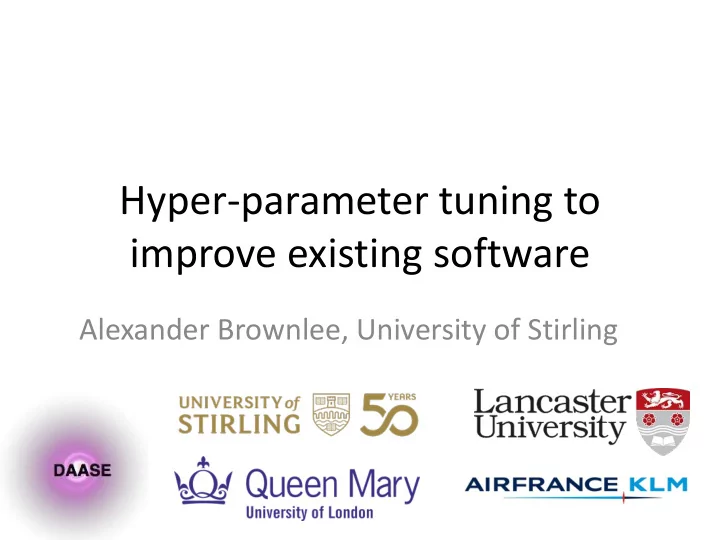

Hyper-parameter tuning to improve existing software Alexander Brownlee, University of Stirling
Collaborators 2
Outline • The software • What to improve? • A systematic approach: – Statistical analysis – Single-objective tuning – Multi-objective tuning • What about GI? 3
Software • OPiuM – Java based simulator, developed in-house at KLM • Built on DSOL library, developed at TU Delft 6
Software • Simulates aircraft movements given a schedule, estimates possible delays • One flight schedule: – E.g. Europe, 3 months, ~17k flights • All KLM flight schedules pass through Opium (soon to include Air France too) 7
Software 8
What to improve? • Opium software is part of a loop of improving and testing schedules • so, faster , and at least the same accuracy 9
Parameter tuning • We were provided with real-world schedules and results covering 2007-2010 • Starting point: Opium has 14 external parameters – These have been manually tuned over about 10 years, and are now mostly "don't touch" – Tune these to improve simulation accuracy (fit to historical data) and simulation run time 10
Wrapper • Needed for any kind of automated improvement 11
A systematic approach 1. Statistical analysis of the parameters 2. Single objective tuning & model based analysis 3. Seeded multi-objective optimisation Results: high-performing configurations, with explanation 12
Stage 1: statistical analysis 1. Statistical Screening – Design of experiments / fractional factorial – Uses lower and upper bounds for each parameter – Screens out insensitive parameters 2. Exploring the sensitive parameters – Fine-grained exploration of each parameter – Exhaustive: accuracy – Response surface: time 13
Statistical Screening (Accuracy) 14
Optimal values: Accuracy • Exhaustive search MLC CMO CG SMO MSE 1 1 1 1 271.6 – Search space of 112 2 1 1 1 271.6 3 1 1 1 271.6 4 1 1 1 271.6 5 1 1 1 271.6 6 1 1 1 271.6 7 1 1 1 271.6 8 1 1 1 271.6 9 1 1 1 271.6 10 1 1 1 271.6 11 1 1 1 271.6 12 1 1 1 271.6 13 1 1 1 271.6 14 1 1 1 271.6 • Matches default params acc=271.628) 1...14 0 1 1 271.6 • Importance, high to low: 2...14 1 0 1 292.7 1 1 0 1 306.9 – Swap Measure On 1...14 0 0 1 306.9 2...14 1 1 0 366.2 – Create Gamma 2...14 1 0 0 453.3 1 1 1 0 564.0 – Cancel Measure On (negligible?) 1...14 0 1 0 564.0 1 1 0 0 646.9 – Max Legs Cancel (negligible?) 1...14 0 0 0 646.9 15
Time • Same process for time, but second stage was a response surface experiment (6 params, 520 solutions) • Optimal config: – Run time 476.5s (default was 1406.7) – Accuracy (MSE) 426.988 (default was 271.628) • So some potential for improvement 16
Stage 2: single-objective tuning • Automatic Hyper-parameter Optimization – Optimization with irace – Optimization with SMAC – "Optimal" configurations found • Best was acc 241.268 vs 271.628 • Probably because of interactions – Functional ANOVA (fANOVA) main/pairwise interactions 17
fANOVA main/pairwise effects Sum of fractions for main effects 68.91% Sum of fractions for pairwise interaction effects 16.30% 54.25% due to main effect Swap_Measure_On 4.05% due to interaction Swap_Measure_On x Cancel_Measure_On 4.02% due to main effect Cancel_Measure_On 3.57% due to main effect CreateGamma 3.55% due to main effect Rounding_off_method 2.16% due to interaction Swap_Measure_On x Slack_Selection_BB3 2.13% due to main effect Slack_Selection_BB3 1.35% due to interaction Slack_Selection_BB3 x Cancel_Measure_On 1.28% due to interaction Swap_Measure_On x Rounding_off_method 0.84% due to interaction Swap_Measure_On x CreateGamma 0.82% due to interaction Slack_Selection_BB3 x CreateGamma 0.75% due to interaction CreateGamma x Cancel_Measure_On 0.63% due to main effect Ground_Factor_Out 0.55% due to interaction Slack_Selection_BB3 x Rounding_off_method 0.48% due to interaction Slack_Selection_BB3 x HSF_threshold 0.44% due to interaction Slack_Selection_BB3 x HSF_threshold_In 0.36% due to interaction Rounding_off_method x CreateGamma 0.33% due to main effect HSF_threshold 0.33% due to main effect HSF_threshold_In 0.33% due to interaction Swap_Measure_On x HSF_threshold_In 0.31% due to interaction Swap_Measure_On x Ground_Factor_Out 0.31% due to interaction Swap_Measure_On x HSF_threshold 0.25% due to interaction Rounding_off_method x Cancel_Measure_On 0.24% due to interaction HSF_threshold_In x Cancel_Measure_On 0.21% due to interaction HSF_threshold x Cancel_Measure_On 0.15% due to interaction Rounding_off_method x HSF_threshold_In 0.15% due to interaction HSF_threshold_In x CreateGamma 0.13% due to interaction Rounding_off_method x Ground_Factor_Out 0.12% due to interaction HSF_threshold x CreateGamma 0.10% due to interaction Slack_Selection_BB3 x Ground_Factor_Out 18
Integer marginal distributions
Continuous marginal distributions 252.5 265 260 250.0 Performance Performance 255 247.5 250 245 245.0 240 242.5 1.0 1.5 2.0 2.5 0.00 0.25 0.50 0.75 1.00 Ground_Factor_Out Max_Maintenance_Reduction
Stage 3: Multi-objective Optimisation • Improvement in both objectives! • Highlighted params correspond with statistical analysis 21
Where next? • The results are good, but can we do better? • Possible deep parameter tuning – Hundreds of parameters internally – Relatively simple to identify and apply further search • Genetic improvement – DSOL library is open source, currently developing a project to explore GI on this – Prime candidates are searching the space of Java API classes such as containers, and lower-level improvements to source code 22
Conclusions • Start simple! Having written the wrapper, parameter tuning is fairly easy to try • The results were better than expected: improving both speed and accuracy • Value-added optimisation – we added deeper analysis of the parameters that has been fed back to developers • Ready for deeper GI improvement at code level 23
Thanks for listening sbr@cs.stir.ac.uk Questions? 24
Recommend
More recommend